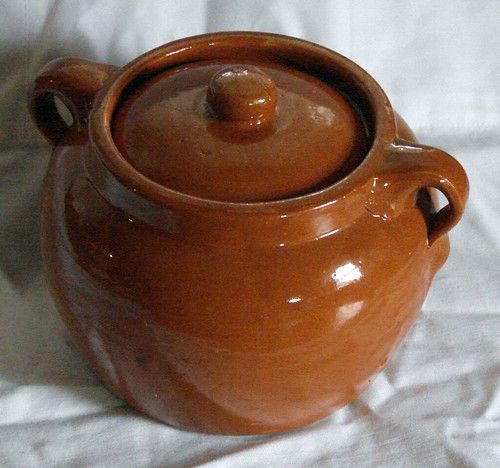 Once upon a time, beanpots were ubiquitous in New England kitchens. In the fall and winter, it was traditional to put a pot of beans in a slow oven overnight, so there would be delicious baked beans for Sunday supper. But, like so many other regional customs, homemade baked beans have become increasingly rare. Many "baked bean" recipes I come across these days list canned baked beans as an ingredient, with one of the first instructions something like "Start with a can of baked beans..."
Once upon a time, beanpots were ubiquitous in New England kitchens. In the fall and winter, it was traditional to put a pot of beans in a slow oven overnight, so there would be delicious baked beans for Sunday supper. But, like so many other regional customs, homemade baked beans have become increasingly rare. Many "baked bean" recipes I come across these days list canned baked beans as an ingredient, with one of the first instructions something like "Start with a can of baked beans..."I love the simple, utilitarian elegance of a well-thrown beanpot. The narrow, collared mouth; the broad shoulders curving to a tapered base; the tightly looped handles which often finish in a gracefully rendered lambs-tongue form. I have a couple dozen of them, each of them different in style, glaze, or decoration but all of them identical in function. Most are antiques - pottery and stoneware last forever if well cared for - but a few are modern.
Beanpots, like so many other wonderful vintage kitchen items, are readily available at thrift stores, rummage sales, and estate sales. You can buy a new one, of course, but old ones are so much more satisfying. For one thing, they're a lot cheaper - not a single beanpot in my collection, not even the most valuable antique salt-glazed pot, cost me more than $8.00. But far more intriguing to me is the idea that the 80- or 100- or 150-year-old bean pot bubbling with pork and beans in my oven right now has seen generations of families, hundreds of bean suppers, and the interiors of ovens from brick hearths to woodstoves to my modern gas appliance.
And just in case I've inspired you to go out looking for a beanpot, click here for my recipe.
.

Great post! thank you for sharing
ReplyDeleteThis is one of the early posts that first brought me to your blog. This post gave me the baked bean fever and I went on to bake some from a recipe I have come to enjoy. I need to get a traditional bean pot, like you suggest here. Mine has a wide mouth, not a narrowed one. Anyway, I do want to try your recipe. The one I use is very good; from the Barefoot Contessa:
ReplyDeletehttp://www.foodnetwork.com/recipes/maple-baked-beans-recipe/index.html
Alan